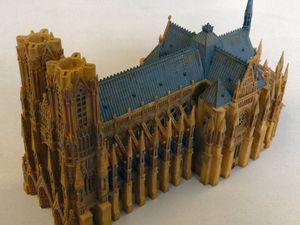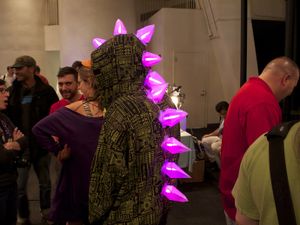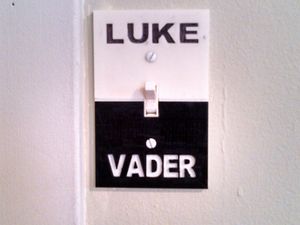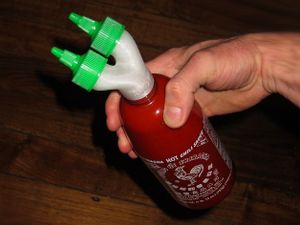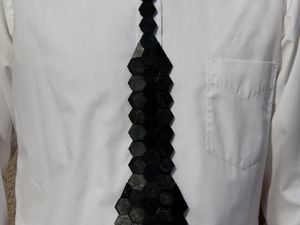User:Nhp5023/Class Blog
Main | About Me | Class Blog
Weekly blog posts on topics stemming from 3D printing.
Blog 1
A) Something Amazing/Beautiful
The Relms Cathedral Kltset is a beautiful 3D printed piece of art. According to the description, this kitset consists of 62 printed pieces and all parts are drawn from scratch referencing other sources. I personally think it is simply amazing to see the details produced by the printer. This is a work of art that I would love to show it to the world.
B) Something Funny or Strange
Well I thought I have seen it all, unfortunately I have not. I had a good laugh when I first saw the Stegoasuarus Dinosaur Costume Spikes – LED Halloween. Having this for Halloween at State College would be amazing! I would love to be a dinosaur for Halloween! The spikes that were printed looked really detailed and each has a unique look to it.
C) Something Useless
Although the idea of the Wall Switch Plate is meant to be funny with converting to darkness will save you money by switching off the lights, I just don’t see any useful ideas behind it. It’s a comedic printed piece, and means nothing more. If you are not a Star Wars fan, I think you’ll just think that this is just weird or just won’t pay attention to it.
D) Something Useful
I love Sriracha hot sauce and this little object (Dual Chili Extruder) has just made me love the sauce even more. Double the nozzle means double the amount of sauce output! Plus, you can use it to put sauce on two hot dogs!
E) Something Surprising
I did not know that you can make a tie out of 3D printed parts. This is a really cool and innovative design of a hex shaped tie. There are lots of parts that have to be put together, but in the end, you get a flexible plastic tie!
Blog 2: Open Source Ecology (OSE) Project
A) General Impressions of the Open Source Ecology (OSE) Project
The video demonstrated the greater possibility of modular technology. The fact that a tractor can be built within a couple of hours seemed to be too good to be true. Nevertheless, it is true and the project itself is showing noticeable growth regarding the expansion of the ideas and community. The greatest impact regarding the project would be leaning toward third-world and developing countries. Such development would provide the developing areas with opportunities to grow economically and so the people would benefit in the process. However, with such freedom regarding the constructions and the affordable prices, agricultural companies (i.e. John Deere) would most likely be in opposition to the project as it has a great chance of affecting the market of their agricultural products.
Further research has shown great progression in developing the toolkit for agricultural machines. In fact, OSE has a development wiki that contains the first civilization starter kit, which contains open source manuals for some of the prototypes that the groups have designed. For instance, there is an 89 pages guide on how to make the 2011 version CEB Press [1]. If I have genuine interests and resources, I will certainly make an attempt at building one of these machines.
I personally would love to see this come to fruition. As the saying goes, there are many possible solutions for a particular problem.
B) New Yorker Magazine and Marcin Response
The author of the article “The Civilization Kit” [2], Emily Eakin, wrote a critical piece on Marcin Jakubwski’s ideology on self-sufficient industrial/agricultural machines. Moreover, she rather focused on ridiculing his daily lifestyle than that of his ideology and accomplishments. His early routine of doing yoga and meditation for two hours should not be main concerns, but apparently it does matter according to Emily Eakin. She does mention an interesting point regarding the supporters of the project though. She stated that “the people who show up at his farm typically display more enthusiasm for [Marcin’s] ideas than expertise with a lathe or a band saw.” I agree with it to a certain extent as enthusiasm can only go so far. Skillful supporters are what Marcin needs to bring the project further.
Marcin’s response [3] to the article is considerably professional. He cleared up confusions about certain topics regarding the project such as funding, development and goals. He also used this opportunity to defense his points. I am a little confused on his definition of an average person to rise to the occasion in his “Big Hairy Audacious Goal” section. What does he considered as average? An average person with interests, but no skills cannot just go out and build his or herself a tractor. Perhaps he meant an average person with similar academic and machining skills as him. However, an average outside observer will not consider such case. This project is not an individual, but a team effort.
C) PSU OSE Club Possibilities
Although administration or trustees would not support such a thing, I believe there are professors within the Penn State community that are interests and willing to give the idea a try. Since this involves agricultural development, the first group of people I would go to would exist within the agricultural engineering department. I believe that there will be professors within the agricultural fields that would be interests in learning more about the modular technology that the project possesses. Thus, further research would be conducted within the interests of the professors. Furthermore, even manufacturing engineering could relate to what the project is aiming for. Nevertheless, funding could be a big problem. Only through the generation of interests by the majority of the community (i.e. students, faculty, etc.) would spark the possibility of starting something such as the OSE at Penn State.
Blog 3: 3-D Printed RoboHand
A) Who created this design and when/where was it done?
The article talks about a teenager from Kansas, named Mason Wilde, who 3-D printed a robot hand for his family friend’s young son named Matthew. The young kid was born with a condition called “limb difference”, which causes him to have no fingers on his right arm. Mason decided to take on the project after suffering from a concussion from playing football. The mechanical arm costs him roughly 60$ worth of materials and 8 hours of printing time. The idea of the robotic hand was started by Van As when he lost a finger in an accident. He then got in contact with a theatrical artist named Owen who specializes in making puppet mechanical limbs. The first metal prototype was made in November 2012. It was made for a son of a South Africa woman. Then in January 2013, they created the first 3-D printer version and the instructions were put up online for free.
B) If you wanted to make one, where would you go to get it?
I would go to the Thingiverse website [4] to get more information on how to make one. The page contains different designs and also CAD (.stl) files for one to download and 3-D print. Of course, I would need access to a 3-D printer.
C) How many news articles can you find which reference this technology?
USA Today [5] The Wall Street Journal [6] PC Magazine [7] NBC News [8] MakerBot [9]
